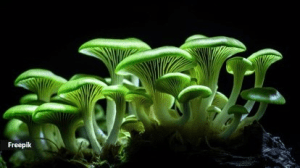TAG: GS 3: ECOLOGY AND ENVIRONMENT
THE CONTEXT: In a significant botanical discovery, scientists have identified a rare species of bioluminescent mushrooms, Filoboletus manipularis, in the forests of Kasaragod, Kerala.
EXPLANATION:
- This finding not only enriches our understanding of fungal biodiversity but also brings attention to the unique and mesmerizing properties of these fungi.
- The discovery was made during a micro-fungal survey conducted by the Kasaragod division of the Kerala Forest and Wildlife Department in collaboration with the Mushrooms of India Community.
- The survey took place in the Ranipuram forest and involved a team of scientists and researchers.
- The survey uncovered over 50 different species of mushrooms, with Filoboletus manipularis being the most noteworthy due to its bioluminescent properties.
- This species emits a brilliant green light in the darkness of night, making it a rare and spectacular find.
Filoboletus manipularis
- Filoboletus manipularis is known for its bioluminescent
- Bioluminescent capability is the result of a biochemical process involving the pigment luciferin and the enzyme luciferase, in the presence of oxygen.
- This reaction produces light, similar to the mechanism observed in fireflies and certain marine organisms.
- These mushrooms thrive in tropical, humid environments, typically found in dense forests with abundant decaying organic matter like fallen trees and leaves.
- The rich, moist environment provides the necessary nutrients and conditions for their growth and glowing property.

Biological and Ecological Significance
- The discovery of Filoboletus manipularis adds a new dimension to our understanding of fungal biodiversity.
- This species offers a glimpse into the wonders of nature and contributes to the ecosystem by breaking down organic matter.
- The bioluminescent properties of Filoboletus manipularis open up new avenues for scientific research.
- By studying their genetic makeup, scientists can gain insights into the mechanisms of bioluminescence and potentially discover new species, enhancing our knowledge of fungal ecosystems.
Health Risks and Consumption Warning
- Despite their enchanting appearance, Filoboletus manipularis mushrooms are deemed not fit for consumption.
- The chemicals responsible for their bioluminescence could be toxic, leading to severe gastrointestinal issues or worse if ingested.
- Rai emphasizes that many wild mushrooms contain harmful toxins, and bioluminescent species are no exception.
- Until more research is conducted, it is advised to admire these mushrooms for their beauty rather than considering them as a food source.
- The potential health risks underscore the importance of exercising caution with wild mushroom consumption.

